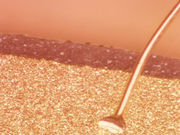Application of Integra bilayer wound matrix followed by grafting has low morbidity
MONDAY, Nov. 30, 2015 (HealthDay News) — Reconstruction of scalp defects including application of Integra bilayer wound matrix followed by delayed split-thickness skin grafting results in low morbidity, with minimal wound care, according to a study published online Nov. 25 in JAMA Facial Plastic Surgery.
Matthew A. Richardson, M.D., from the University of Mississippi Medical Center in Jackson, and colleagues describe a novel reconstruction technique for full-thickness scalp defects that can be performed rapidly without general anesthesia or free flap reconstruction. Data were reviewed for 10 patients (age range, 50 to 87 years; eight men), who underwent surgical resection of a cutaneous lesion at a single medical center. Reconstruction included application of Integra bilayer wound matrix followed by delayed split-thickness skin grafting. Patients were followed for a mean of 481.1 days.
The researchers found that all patients had excellent skin graft and wound closure outcomes. The initial take of the skin graft to the defect site was 100 percent for nine of the patients; one patient showed a 95 to 100 percent initial take. Acceptable cosmetic results were achieved with adequate coverage of the wound bed. Two of the patients required postoperative intensity-modulated radiotherapy, one of whom experienced radiotherapy-induced wound breakdown at 3.5 months after therapy completion, which resolved completely after more than six months.
“This novel technique for reconstruction of large full-thickness scalp defects has low morbidity and can be performed on an outpatient basis with minimal wound care,” the authors write.
Copyright © 2015 HealthDay. All rights reserved.








